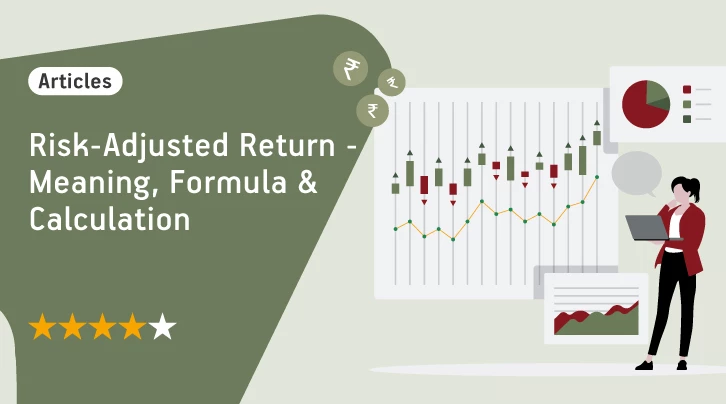You take a certain amount of risk to generate returns from your investment. Risk-adjusted return can help you calculate this risk. Keep reading to find out more.
While the risk profile can vary, risk is an inherent part of every investment. So, while every investor wants to generate returns from their investments, it is also vital to know the amount of risk you’re taking to generate the potential returns.
Risk-adjusted return is a metric for calculating an investment's potential returns against the associated risk. Let’s take a look at what risk-adjusted return is, its formula, and more-
What is Risk-Adjusted Return?
Risk-adjusted return is a measure to estimate an investment's return by considering the degree of risk associated with it. It helps the investor to compare low-risk and high-risk return investments. Risk-adjusted return helps an investor to determine whether he is getting the maximum possible gains with minimal risk.
With the risk-adjusted return, investors can approximate the risk they are taking or willing to take to generate returns from an investment. You can use this metric to compare individual securities and mutual funds and even analyse overall portfolio performance.
The risk-adjusted return of an investment is generally expressed in ratings, numbers, or ratios. You can compare the risk-adjusted return of an investment with your risk profile to make informed investment decisions.
How is Risk-Adjusted Return Calculated?
There’s no single risk-adjusted return formula. Instead, multiple metrics can help you analyse the risk profile of an investment. Some of the most commonly used metrics are-
● Alpha
Alpha measures your investment against its benchmark to see whether it is outperforming or underperforming. For instance, the performance of an equity mutual fund can be compared to the NIFTY50 index to calculate its Alpha.
● Beta
Beta is a volatility metric that measures the risk profile of an investment against the broader market. If the Beta of investment is higher than 1, it is considered more volatile than the market.
● Standard Deviation
Standard deviation measures how the returns from an investment vary against its average or mean returns over a specific period.
Based on these metrics, you can use the risk and return formula for ratios like Sharpe to measure risk-adjusted returns. Take a look-
Sharpe Ratio
Formula- [(ROI-Risk-Free Rate)/Standard Deviation]
For example, there are two investments – A and B. In the last year, Investment A generated 20% returns with a standard deviation of 8%. Investment B, on the other hand, generated 15% with a standard deviation of 5%. The risk-free rate or the rate of returns from a potentially risk-free investment like traditional saving instrument is 4%.
So, the Sharpe Ratio of these investments will be-
Investment A Sharpe Ratio= [(20-4)/8] = 2
Investment B Sharpe Ratio= [15-4/5] = 2.2
So, while Investment A delivered more returns, the adjusted-risk-return is higher with Investment B.
Disclaimer - The calculations provided above are based on assumed rate of returns and it are meant for illustration purposes only. Loads are not taken into consideration in the above investment simulation. Returns greater than one year are compounded annualized growth rate.
Why Consider Risk Before Investing?
Here are some of the reasons why you should analyse the risk profile of an investment before investing-
● Select the Right Investments
The risk profile of every investor is different. By analysing the risk-adjusted return of an investment, you can better select investments that suit your risk profile.
● Evaluate Fund Manager/Financial Advisor Performance
With the help of risk-adjusted return, you can also accurately analyse the performance of a mutual fund’s manager or even your financial consultant or advisor. You can know the amount of risk being taken on your money to deliver potential returns.
● Peace of Mind
Knowing you’ve selected investments that align with your risk appetite gives you peace of mind. It makes you more confident and takes you closer to your financial objectives.
Using Risk-Adjusted Return to Analyse Your Investments
Risk-adjusted return is an excellent metric to analyse the risk profile of your investments. But while it offers a quick snapshot of the risk an investment takes to generate potential returns, avoid investing solely based on this metric, as many other factors deserve your attention.
If you’re new to mutual funds, consult an investment advisor who can help you build a portfolio according to your objectives and risk appetite.
Mutual Fund investments are subject to market risks, read all scheme related documents carefully.





 1800-270-7000
1800-270-7000




